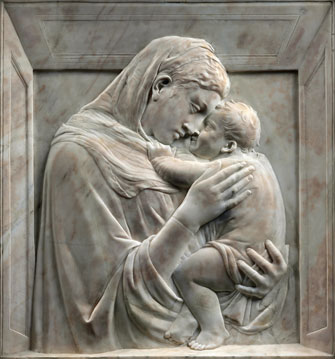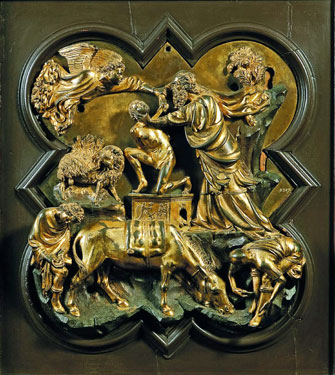Sculptural Glories of the
Renaissance Revisited

Donatello’s “Pazzi Madonna” (c. 1420-25).
© Skulpturensammlung und Museum für Byzantinische Kunst, Staatliche Museen zu Berlin – Preußischer Kulturbesitz/Antje Voigt Staatliche Museen zu Berlin – Preußischer Kulturbesitz/Antje Voigt
The Louvre’s sumptuous new exhibition, “The Springtime of the Renaissance: Sculpture and the Arts in Florence, 1400-1460” is a felicitous reminder of the great beauty and elegance of the art being produced in Florence during the Quattrocento.
The curators locate the origins of this brave new world, whose influence radiated throughout the arts and humanities, in sculpture rather than in painting.
To set the stage for the return to Classicism that characterized the Renaissance, the exhibition starts with the Talento Crater (1st century BCE), an impressive Roman vase sculpted in relief with lithe, beautifully modeled dancers; it inspired many Tuscan artists, including Nicola Pisano. This section of the exhibition includes works by him and other 13th- and 14th-century artists, among them French sculptors whose Gothic expressiveness (shown here through two beautiful 13th-century statues of the Madonna and Child, one from Paris and the other from Picardy) are said to have influenced such Italian sculptors as Nicola’s son Giovanni Pisano.
The Gothic and Classical influences meet and begin to merge at the very beginning of the 15th century in two entries from the famous competition for the doors of the Baptistery in

Lorenzo Ghiberti’s “The Sacrifice of Isaac” (1401). © Lorenzo Mennonna, courtesy of Italian Ministry for Cultural Heritage and Activities

Filippo Brunelleschi’s “The Sacrifice of Isaac” (1401). © Lorenzo Mennonna, courtesy of Italian Ministry for Cultural Heritage and Activities
Florence, both illustrating the sacrifice of Isaac: Lorenzo Ghiberti’s winning gilt-bronze relief and Filippo Brunelleschi’s accomplished piece. The latter is said by some to have “inaugurated” the Renaissance with its references to Classical themes like the famous and oft-copied Antique statue “Boy with Thorn,” while its composition still follows the medieval model. Ghiberti’s piece shows the influence of late Gothic elegance and Classical sculptural forms.
The exhibition does a good job of showing the Classical influence on the Renaissance by occasionally displaying Roman and Greek pieces next to later interpretations of them. The dialogue between sculpture and painting is also well illustrated with works by Giotto, Masaccio, Filippo Lippi and others, as well as sculpted reliefs that incorporate the newly discovered use of linear perspective.
The star of this show full of beautiful pieces is unquestionably Donatello, represented by some 13 works, among them the sublimely elegant yet expressive “Madonna and Child” (c. 1420-25; pictured above), known as the “Pazzi Madonna,” a marble bas-relief in which mother and child, seen in profile nose to nose, seem to be merging into one another against an architectural backdrop that follows Brunelleschi’s rules for perspective. The great sculptor’s magnificent “Carafa Protome” (c. 1455) horse’s head, made for the Monument to Gattamelata, is also here, dramatically displayed at the entrance to the show near the “Medici Protome,” a Greek bronze dating from the 4th century BCE, which pales slightly next to Donatello’s version, so full of life and movement, with its rolling eyes and flaring nostrils.
This exhibition is so packed with masterpieces that it can be fully enjoyed just for its own sake without understanding the story it is trying to tell, but for once I think the Louvre has erred on the side of under-explanation. I wanted to know more about why certain pieces were included and only found out by doing further research after seeing the show. Nevertheless, this important, uplifting exhibition is a must for any art lover.
Musée du Louvre: Hall Napoléon. Métro: Palais-Royal-Musée du Louvre. Open Wednesday-Monday, 9am-6pm (until 9.45pm on Wednesday and Friday). Closed Tuesday, December 25 and January 1. Admission: €13. Through January 6, 2014. www.louvre.fr
Click here to read all of this week’s new articles on the Paris Update home page.
Reader reaction: Click here to respond to this article (your response may be published on this page and is subject to editing).
Please support Paris Update by ordering books from Paris Update’s Amazon store at no extra cost. Click on your preferred Amazon location: U.K., France, U.S.
More reviews of Paris art shows.
© 2013 Paris Update
Favorite